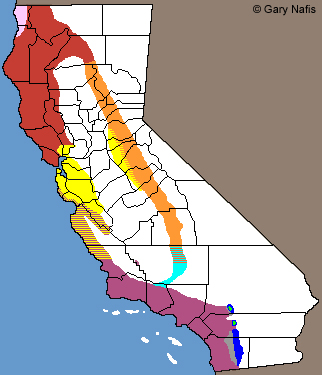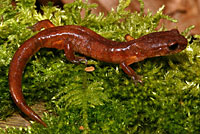|
 |
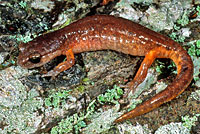 |
| Adult, Sonoma County |
Adult, Humboldt County |
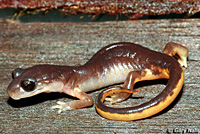 |
 |
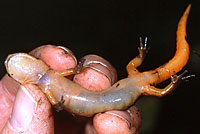 |
| Adult, Mendocino County |
Underside of adult, Mendocino County |
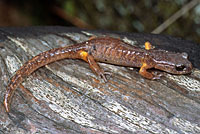 |
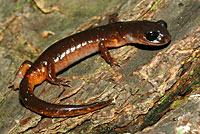 |
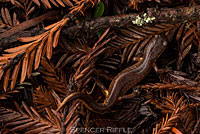 |
| Adult, Siskiyou County |
Adult, Sonoma County |
This picture of a Humboldt County adult shows how well this Ensatina's body coloring allows it blend in and hide on the forest floor. © Spencer Riffle |
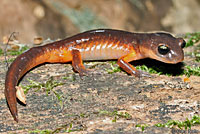 |
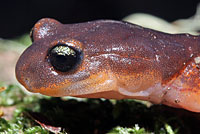 |
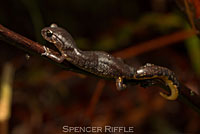 |
| Adult, Marin County |
Ensatina are not known as climbing salamanders, but they are capable of climbing. This adult was observed on a small branch about two feet above the ground in Humboldt County.
© Spencer Riffle |
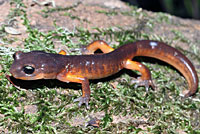 |
 |
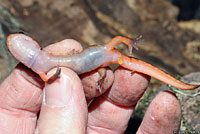 |
| |
Adult, Marin County |
|
 |
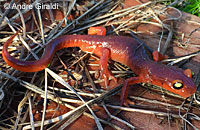 |
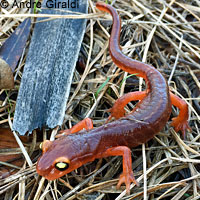 |
| Adult out on the crawl near the edge of a log in a redwood forest in Marin County © Max Roberts |
This Ensatina comes from the intergrade area in northern Marin County, but it looks very much like a pure Yellow-eyed Ensatina. (Compare its body color and the amount of yellow in its eye with the other Marin County Ensatina shown above.)
© Andre Giraldi |
| |
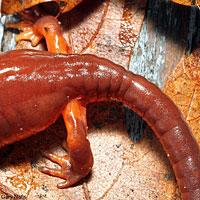 |
|
| |
The tail of an Ensatina is
constricted at the base |
|
| |
|
|
Juveniles |
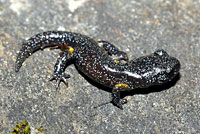 |
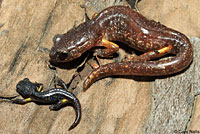 |
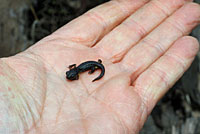 |
| Hatchling, Siskiyou County |
Juvenile and adult, Siskiyou Mountains, Siskiyou County |
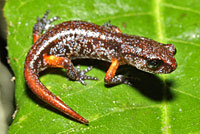 |
 |
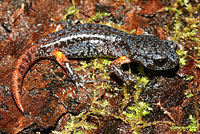 |
| Juvenile, Humboldt County |
Tiny Juvenile, Mendocino County |
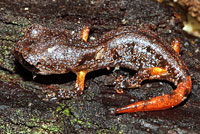 |
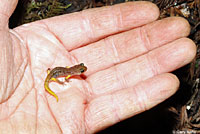 |
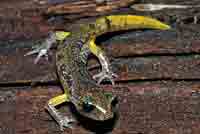 |
| Tiny juvenile, Sonoma County |
Juvenile, Humboldt County |
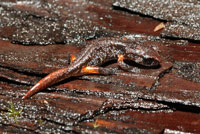 |
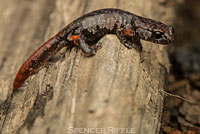 |
 |
| The dark color and bright speckling of a juvenile ensatina helps to camouflage it on the fallen wet wood of its habitat. |
Hatchling, Humboldt County
© Spencer Riffle |
These two hatclings with different coloring were found in Sonoma County under the same log..The photographer has never seen one with yellow coloring in the area, which brings up the question why are some hatchlings orange and some yellow and are hatchlings with both colors found in the same clutch?
© Laura Baker |
| |
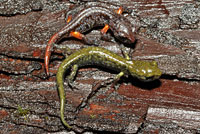 |
|
| |
Juvenile, Humboldt County, with juvenile Black Salamander - Aneides flavipunctatus for comparison.
|
|
| |
|
|
Intergrades or Hybrids |
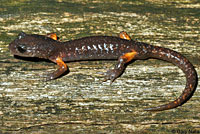 |
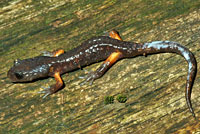 |
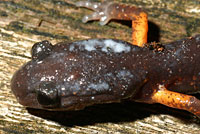 |
| E. e. platensis x E. e. oregonensis intergrade adult, Shasta County, before and after excreting milky defensive fluids. |
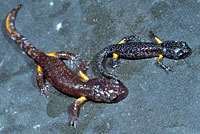 |
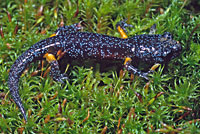 |
 |
| E. e. platensis x E. e. oregonensis intergrades, Shasta County |
E. e. platensis x E. e. oregonensis juvenile, Shasta County |
E. e. platensis x E. e. oregonensis intergrade adult, Shasta County
© Spencer Riffle |
| |
|
|
| Abberent Ensatina |
 |
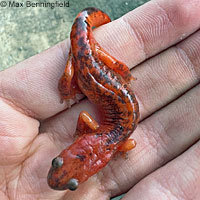 |
| This adult with unusual dark blotches on the skin was found in southern Marin County. © Max Benningfield |
| |
|
|
| Courtship |
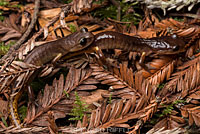 |
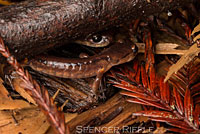 |
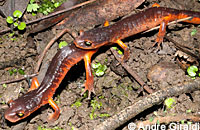 |
| Courting adults, Humboldt County © Spencer Riffle |
Adults courting at night in January, Marin County © Andre Giraldi |
 |
|
| Courting adults, Marin County © Adam Gitmed |
|
| |
|
|
| Eggs and Hatchlings |
 |
 |
 |
| On August 25th. Linda Bostwick and Mel Smith discovered an adult Ensatina guarding her eggs inside a water meter box in Mendocino County. © Mel Smith |
 |
 |
 |
| By September 10th the eggs had hatched and the mother and at least 11 hatchlings had not yet left the nest site. © Mel Smith |
On October 10th 5 of the hatchlings and the mother were still present.
© Mel Smith |
Observations on September 25th and October 1st showed that only 5 of the hatchlings were still present along with the mother. (The others may have climbed out or maybe they were victims of predation.)
|
On October 27th a second adult was observed and 5 or more hatchlings were still present.
|
 |
|
|
On November 15th only three of the hatchlings were stil in the box. As is to be expected, most of the salamanders waited until the rains were well underway to leave.
|
By November 20th, all of the hatchlings had apparently left the nest site in the water meter box.
On November 23rd one hatchling had returned.
|
| |
|
|
| Defense |
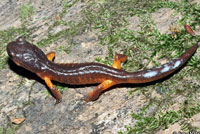 |
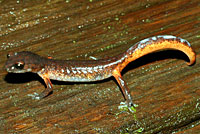 |
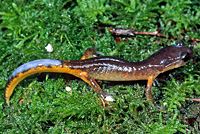 |
Adult, Marin County, with milky
defensive secretions on tail. |
Adult, Humboldt County, in defensive pose, with milky secretions on tail. |
Adult, Mendocino County, with milky defensive secretions on tail. |
| |
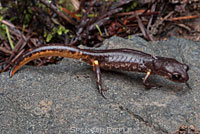 |
|
| |
Adult unken reflex defensive pose, Humboldt County © Spencer Riffle |
|
| |
|
|
| Oregon Ensatinas From Oregon and Washington |
 |
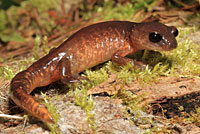 |
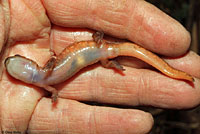 |
Adult and young juvenile,
Lane County, Oregon |
Adult, Lane County, Oregon |
|
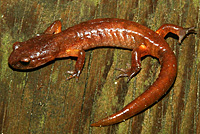 |
|
| Adult, King County, Washington |
|
| |
|
| Intergrades with Sierra Nevada Ensatina |
 |
 |
 |
| E. e. platensis x E. e. oregonensis intergrade adult, Shasta County, before (left) then after excreting milky defensive fluids. |
 |
 |
 |
| E. e. platensis x E. e. oregonensis Adult and juvenile intergrades, Shasta County |
E. e. platensis x E. e. oregonensis juvenile, Shasta County |
E. e. platensis x E. e. oregonensis intergrade adult, Shasta County
© Spencer Riffle |
| |
|
|
| Habitat |
 |
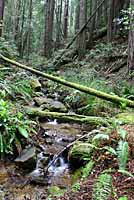 |
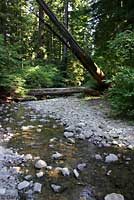 |
| Habitat, Mendocino County |
Habitat, Sonoma County |
Habitat, Humboldt County |
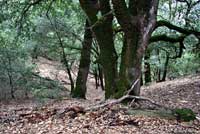 |
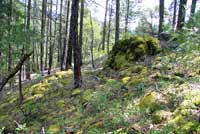 |
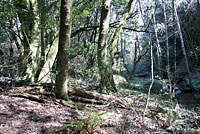 |
| Habitat, Shasta County |
Habitat, 2,600 ft., Siskiyou County
|
Habitat, Marin County |
You can see more pictures of Oregon Ensatinas and their habitat from Washington and Oregon here.
|
| Short Videos |
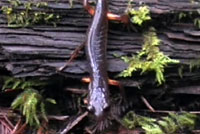 |
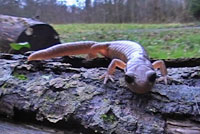 |
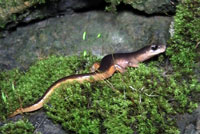 |
An adult Enstaina crawls around on the forest floor. A juvenile shows it can move very fast when it wants to.
|
Several adult Oregon Ensatinas and a tiny black juvenile which has lost its tail wish they could crawl back under their logs in Washington. |
A couple of adult Ensatina discovered out on the surface at night in Marin County |
|
|
|
| Description |
| |
| Size |
An adult Ensatina measures from 1.5 - 3.2 inches long (3.8 - 8.1 cm) from snout to vent, and 3 - 6 inches (7.5 - 15.5 cm) in total length.
|
| Appearance |
A medium-sized salamander.
The legs are long, and the body is relatively short, with 12 - 13 costal grooves.
Nasolabial grooves are present.
The tail is rounded and constricted at the base, which will differentiate this salamander from its neighbors.
|
| Color and Pattern |
This subspecies is light to dark brown above with small yellow to orange flecks.
The sides are yellowish-orange and mottled with light markings.
The underside is whitish with fine black speckling.
There is yellow to orange coloring on the base of the limbs.
Juveniles have dark blotches on the body and tail, but typically have the yellow or orange limb coloring. |
| Male / Female Differences |
Males have longer, more slender tails than females, and a shorter snout with an enlarged upper lip, while the bodies of females are usually shorter and fatter than the bodies of males.
|
| Life History and Behavior |
A member of family Plethodontidae, the Plethodontid or Lungless Salamanders.
Plethodontid salamanders do not breathe through lungs. They conduct respiration through their skin and the tissues lining their mouth. This requires them to live in damp environments on land and to move about on the ground only during times of high humidity. (Plethodontid salamanders native to California do not inhabit streams or bodies of water but they are capable of surviving for a short time if they fall into water.)
Plethodontid salamanders are also distinguished by their nasolabial grooves, which are vertical slits between the nostrils and upper lip that are lined with glands associated with chemoreception.
All Plethodontid Salamanders native to California lay eggs in moist places on land.
The young develop in the egg and hatch directly into a tiny terrestrial salamander with the same body form as an adult.
(They do not hatch in the water and begin their lives as tiny swimming larvae breathing through gills like some other types of salamanders.)
|
| Activity |
Ensatina live in relatively cool moist places on land becoming most active on rainy or wet nights when temperatures are moderate. They stay underground during hot and dry periods where they are able to tolerate considerable dehydration.
They may also continue to feed underground during the summer months.
High-altitude populations are also inactive during severe winter cold. Longevity has been estimated at up to 15 years. |
| Territoriality |
| Adults have been observed marking and defending territories outside of the breeding season. |
| Longevity |
| Longevity has been estimated at up to 15 years. |
| Defense |
When it feels severely threatened by a predator, an Ensatina may detach its tail from the body to distract the predator. The tail moves back and forth on the ground to attract the predator while the Ensatina slowly crawls away to safety. The tail can be re-grown.
The tail also contains a high density of poison glands. When disturbed, an Ensatina will stand tall in a stiff-legged defensive posture with its back swayed and the tail raised up while it secretes a milky white substance from the tail, swaying from side to side. This noxious substance repels predators, although some experienced predators learn to eat all but the tail. The poison is also exuded from glands on the head.
If a person gets the poison on their lips, they will experience some numbness for several hours.
(Charles Brown - Ensatina.net)
Rarely, an Ensatina may make a hissing or squeaking sound when threatened. |
| Predators |
Predators include Stellar's Jays, gartersnakes, and racoons.
(Kuchta and Parks, Lanoo ed. - Amphibian Declines... 2005) |
| Diet and Feeding |
Ensatinas eat a wide variety of invertebrates, including worms, ants, beetles, spiders, scorpions, centipedes, millipedes, sow bugs, and snails.
They expel a relatively long sticky tongue from the mouth to capture the prey and pull it back into the mouth where it is crushed and killed, then swallowed.
Typically feeding is done using sit-and-wait ambush tactics, but sometimes Ensatinas will slowly stalk their prey. |
| Sound |
"Rarely, it may produce a squeak or snakelike hiss, quite a feat for an animal without lungs!"
(Stebbins & McGinnis 2012)
|
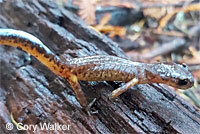 |
This frightened Humboldt County Ensatina is raised up in defensive mode, excreting a milky white defensive liquid on its head and tail. It jerks its head several times, and each time it makes a very faint squeaking sound.
Click the picture to play a short video to hear the squeaking. (You might need to turn the volume all the way up.)
© Cory Walker |
| Reproduction |
Reproduction is terrestrial.
Mating takes place in Fall and Spring, but may also occur throughout the winter.
Stebbins describes an elaborate Ensatina courtship involving the male rubbing his body and head against the female eventually dropping a sperm capsule onto the ground which the female picks up with her cloaca. You can watch an Ensatina courtship video on YouTube.
The female can store the sperm until she determines the time is right to fertilize her eggs.
At the end of the rainy season, typically April or May, females retreat to their aestivation site under bark, in rotting logs, or in underground animal burrows, and lay their eggs. |
| Eggs |
Females lay 3 - 25 eggs, with 9 - 16 being average.
Females remain with the eggs to guard them until they hatch.
(Pictures of Ensatinas with their eggs and hatchlings)
In labs, eggs have hatched in 113 - 177 days. |
| Young |
Young develop completely in the egg and probably leave the nesting site with the first saturating Fall rains, or, at higher elevations, after the snow melts.
|
| Habitat |
Inhabits moist shaded evergreen and deciduous forests and oak woodlands. Found under rocks, logs, other debris, especially bark that has peeled off and fallen beside logs and trees.
Most common where there is a lot of coarse woody debris on the forest floor. In dry or very cold weather, stays inside moist logs, animal burrows, under roots, wood rat nests, under rocks.
|
| Geographical Range |
Oregon Ensatina are traditionally reported as occurring along the Pacific coast from southwest British Columbia south to Sonoma county. Stebbins (2003) eliminated the range of the subspecies E. e. oregonensis in California, showing instead, a very large area of intergradation in California, which means that this subspecies does not actually occur in California in its pure form. A trace of yellow in the eyes remains on most Ensatina found along the north coast of California. This yellow coloring is not found on the pure Oregon Ensatina found in Oregon and Washington, which supports Stebbins' decision. Due to the very large area inhabited by these intergrades, I label them as Oregon Ensatina on this web site even though they might tecnically be intergrades.
Ensatina is the most widely-distributed plethodontid salamander in the West, ranging from an isolated location in the mountains of Baja California north along the extreme northwest coast of Baja California, through most of California excluding the deserts, the central valley, and high elevations in the mountains, continuing north into Oregon and Washington west of the Cascades Mountains, and farther north into Canada along the coast of southern British Columbia. Also found on Vancouver Island.
The range maps in Stebbins (2003 and 2012) show a very large range of intergradation between 4 subspecies in Northern California that at one time was considered part of the range E. e. oregonensis. I show this range on my maps as E. e. oregonensis partly because Stebbins & McGinnis, 2012, report that molecular studies have shown complexities that make the use of the term "intergrade" inaccurate.
|
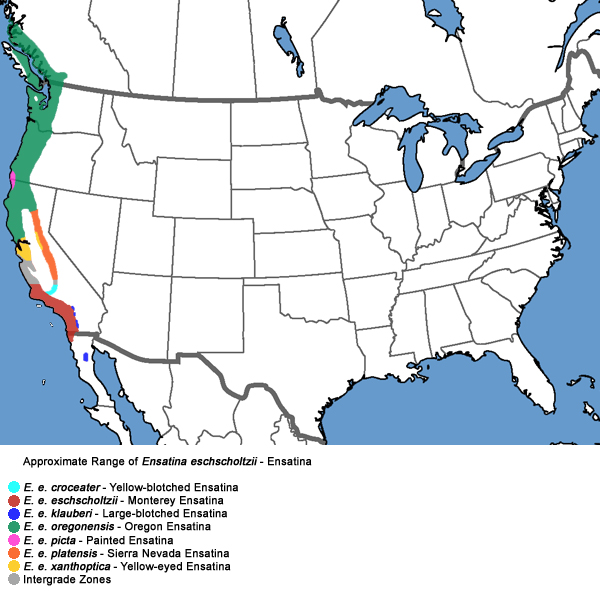 |
| Elevational Range |
In his 2003 field guide, Stebbins shows the elevational range of Ensatina eschscholtzii as "Sea level to around 11,000 ft (3,350 m). That is for the species but not necessarily this subspecies.
|
| Notes on Taxonomy |
Robert Stebbins refers to this taxon not as a subspecies, but as a "morphotype," which he defines as "a morphologically recognizable set of populations with a geographic range that may be out of synchrony with taxonomic findings based on molecular evidence." (Stebbins, 2003) His range map does not show this morphotype occurring in California. The California populations of E. e. oregonensis shown on older range maps are now labeled integrades by Stebbins, and we follow his map. This site treats these intergrades separately from the other subspecies, in order to show some of the variation in their appearance across their widespread distribution in the state.
Ensatina taxonomy is controversial. The species Ensatina eschscholtzii traditionally consists of 7 subspecies:
E. e. croceater
E. e. eschscholtzii
E. e. klauberi
E. e. oregonensis
E. e. picta
E. e. platensis
E. e. xanthoptica
Some researchers see Ensatina eschscholtzii as two or more species that make up a superspecies complex.
They recognize E. e. klauberi, found at the southern end of the ring, as a separate species - Ensatina klauberi.
Ensatina as a Ring Species
Ensatina eschscholtzii has been called a "ring" species, or "Rassenkreis" (race circle) "...a connected series of neighbouring populations, each of which can interbreed with closely sited related populations, but for which there exist at least two 'end' populations in the series, which are too distantly related to interbreed, though there is a potential gene flow between each 'linked' population. Such non-breeding, though genetically connected, 'end' populations may co-exist in the same region thus closing a 'ring'." (Wikipedia, 8/26/17) The "end" populations of Ensatina are the E. e. escholtzii and the E. e. klauberi subspecies, which hybridize in San Diego County.
To learn much more about Ensatina and the ring species concept, check out this Understanding Evolution Research Profile about Tom Devitt's work.
Charles W. Brown explains the taxonomy of the Ensatina complex in detail, describing it as "a classical example of Darwinian evolution by gradualism; an accumulation of micro mutations that is now leading to the formation of a new species."
Illustration of the Ensatina ring:
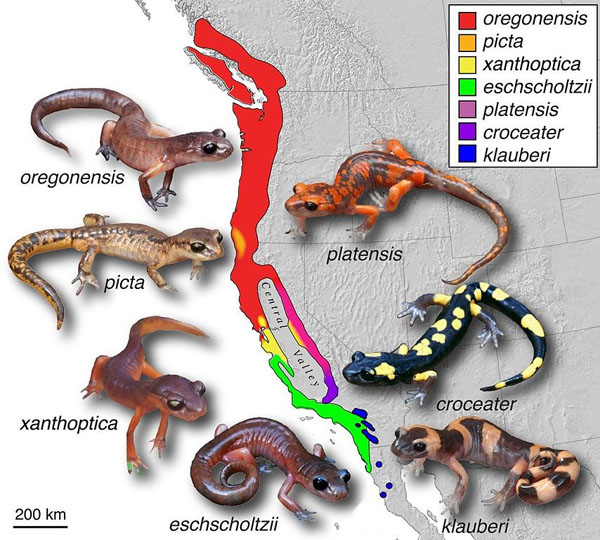
Use: This file is licensed under the Creative Commons Attribution 2.0 Generic license.
Photo Credit: Thomas J. Devitt, Stuart J.E. Baird and Craig Moritz, 2011.
Source: (2011). "Asymmetric reproductive isolation between terminal forms of the salamander ring species Ensatina eschscholtzii revealed by fine-scale genetic analysis of a hybrid zone". BMC Evolutionary Biology 11 (1): 245. DOI:10.1186/1471-2148-11-245.
What Subspecies of Ensatina eschscholtzii Occurs in San Francisco?
Determining the taxonomy of Ensatina eschscholtzii in San Francisco County and the west side of the San Francisco Bay has been challenging:
The range maps in Stebbins, Robert C. Amphibians and Reptiles of Western North America. McGraw-Hill, 1954 and 1985 show them to be intergrades, but they do not indicate whether they itergrade with E. e. eschscholtzii or with E. e. oregonensis.
The large color range map in Thelander, Carl G., editor in chief. Life on the Edge - A Guide to California's Endangered Natural Resources - Wildlife. Berkeley: Bio Systems Books, 1994 that is based on two of Robert Stebbins' works appears to show them as intergrades with E. e. eschscholtzii, though that is not entirely clear.
The range map in Petranka, James W. Salamanders of the United States and Canada. Smithsonian Institution, 1998. shows them to be E. e. oregonensis.
The range maps in Stebbins, Robert C. A Field Guide to Western Amphibians and Reptiles Third Edition. Houghton Mifflin, 2003 and Fourth Edition 2018 are too small to show that part of the peninsula.
The range map in Joao Alexandrino, Stuart J. E. Baird, Lucinda Lawson, J. Robert Macey, Craig Moritz, and David B. Wake. Strong Selection Against Hybrids at a Hybrid Zone in the Ensatina Ring Species Complex and Its Evolutionary Implications. Evolution, 59(6), 2005, pp. 1334–1347 shows them to be E. e. oregonensis
David B. Wake. Problems with Species: Patterns and Processes of Species Formation in Salamanders. Annals of the Missouri Botanical Garden. 93: 8–23. Published on 31 May 2006 shows a range map (click here to see it) based on a preliminary analysis from a study in progress using mitochondrial DNA in which Ensatina on the SF peninsula are shown as E. e. xanthoptica but there are E. e. oregonensis clades shown on the coast south of there. (A color map in the same paper shows the entire area west of the S.F. Bay to be E. e. oregonensis.)
The map used by Devitt, et al, 2011, shown above in their illustration of the Ensatina ring, shows them to be E. e. oregonensis.
A range map in Shawn R. Kuchta, Duncan S. Parks, David B. Wake. Pronounced phylogeographic structure on a small spatial scale: Geomorphological evolution and lineage history in the salamander ring species Ensatina eschscholtzii in central coastal California. Molecular Phylogenetics and Evolution 50 (2009) 240–255 shows them to be E. e. xanthoptica (with E. e. oregonensis to the southwest.) (Click here to see the map.)
The range map in Stebbins, Robert C., and McGinnis, Samuel M. Field Guide to Amphibians and Reptiles of California: Revised Edition (California Natural History Guides) University of California Press, 2012 shows them to be E. e. xanthoptica.
There are certainly more studies with more maps which I have not seen, but since some recent research shows them as E. e. xanthoptica (and photos I've seen of Ensatina from San Francisco corroborate this) I will show them as such until further research shows otherwise.
Alternate and Previous Names (Synonyms)
Ensatina eschscholtzii oregonensis - Oregon Ensatina (Stebbins 2003, 2012)
Ensatina eschscholtzii oregonensis - Oregon Salamander (Ensatina) (Stebbins 1966, 1985)
Ensatina eschscholtzii eschscholtzii - ssp. of Eschscholtz's Salamander (Stebbins 1954)
Ensatina eschscholtzii eschscholtzii - Red Salamander (Oregon Salamander) (Bishop 1943)
Ensatina eschscholtzii - Oregon Salamander (Grinnell and Camp 1917, Storer 1925)
Plethodon eschscholtzii - Oregon salamander, Oregon Triton, Oregon Plethodon (Grinnell and Camp 1917)
Plethodon ensatus (Cope 1867)
Plethodon oregonensis (Girard 1856)
Heredia oregonensis (Girard 1856)
Ensatina eschscholtzii (Gray 1850)
|
| Conservation Issues (Conservation Status) |
| None |
|
| Taxonomy |
| Family |
Plethodontidae |
Lungless Salamanders |
Gray, 1850 |
| Genus |
Ensatina |
Ensatinas |
Gray, 1850 |
| Species |
Eschscholtzii |
Ensatina |
Gray, 1850 |
Subspecies
|
oregonensis |
Oregon Ensatina |
(Girard, 1856) |
|
Original Description |
Ensatina eschscholtzii - Gray, 1850 - Cat. Spec. Amph. Coll. Brit. Mus., Batr. Grad., p. 48
Ensatina eschscholtzii oregonensis - Girard, 1856 - Proc. Acad. Nat. Sci. Philadelphia, Vol. 8, p. 141
from Original Description Citations for the Reptiles and Amphibians of North America © Ellin Beltz
|
|
Meaning of the Scientific Name |
Ensatina - Latin - ensatus = sword shaped + -ina = similar to, possibly referring to the teeth
eschscholtzii - honors Johann F. Eschscholtz
oregonensis - belonging to the state of Oregon, referring to the distribution
from Scientific and Common Names of the Reptiles and Amphibians of North America - Explained © Ellin Beltz
|
|
Related California Salamanders |
Large-blotched Ensatina
Monterey Ensatina
Painted Ensatina
Sierra Nevada Ensatina
Yellow-eyed Ensatina
Yellow-blotched Ensatina
|
|
More Information and References |
California Department of Fish and Wildlife
AmphibiaWeb
Hansen, Robert W. and Shedd, Jackson D. California Amphibians and Reptiles. (Princeton Field Guides.) Princeton University Press, 2025.
Stebbins, Robert C., and McGinnis, Samuel M. Field Guide to Amphibians and Reptiles of California: Revised Edition (California Natural History Guides) University of California Press, 2012.
Stebbins, Robert C. California Amphibians and Reptiles. The University of California Press, 1972.
Flaxington, William C. Amphibians and Reptiles of California: Field Observations, Distribution, and Natural History. Fieldnotes Press, Anaheim, California, 2021.
Nicholson, K. E. (ed.). 2025. Scientific and Standard English Names of Amphibians and Reptiles of North America North of Mexico, with Comments Regarding Confidence in Our Understanding. Ninth Edition. Society for the Study of Amphibians and Reptiles. [SSAR] 87pp.
Samuel M. McGinnis and Robert C. Stebbins. Peterson Field Guide to Western Reptiles & Amphibians. 4th Edition. Houghton Mifflin Harcourt Publishing Company, 2018.
Stebbins, Robert C. A Field Guide to Western Reptiles and Amphibians. 3rd Edition. Houghton Mifflin Company, 2003.
Behler, John L., and F. Wayne King. The Audubon Society Field Guide to North American Reptiles and Amphibians. Alfred A. Knopf, 1992.
Robert Powell, Roger Conant, and Joseph T. Collins. Peterson Field Guide to Reptiles and Amphibians of Eastern and Central North America. Fourth Edition. Houghton Mifflin Harcourt, 2016.
Powell, Robert., Joseph T. Collins, and Errol D. Hooper Jr. A Key to Amphibians and Reptiles of the Continental United States and Canada. The University Press of Kansas, 1998.
American Museum of Natural History - Amphibian Species of the World 6.2
Bartlett, R. D. & Patricia P. Bartlett. Guide and Reference to the Amphibians of Western North America (North of Mexico) and Hawaii. University Press of Florida, 2009.
Bishop, Sherman C. Handbook of Salamanders. Cornell University Press, 1943.
Lannoo, Michael (Editor). Amphibian Declines: The Conservation Status of United States Species. University of California Press, June 2005.
Petranka, James W. Salamanders of the United States and Canada. Smithsonian Institution, 1998.
Corkran, Charlotte & Chris Thoms. Amphibians of Oregon, Washington, and British Columbia. Lone Pine Publishing, 1996.
Jones, Lawrence L. C. , William P. Leonard, Deanna H. Olson, editors. Amphibians of the Pacific Northwest. Seattle Audubon Society, 2005.
Leonard et. al. Amphibians of Washington and Oregon. Seattle Audubon Society, 1993.
Nussbaum, R. A., E. D. Brodie Jr., and R. M. Storm. Amphibians and Reptiles of the Pacific Northwest. Moscow, Idaho: University Press of Idaho, 1983.
Joao Alexandrino, Stuart J. E. Baird, Lucinda Lawson, J. Robert Macey, Craig Moritz, and David B. Wake. Strong Selection Against Hybrids at a Hybrid Zone in the Ensatina Ring Species Complex and Its Evolutionary Implications. Evolution, 59(6), 2005, pp. 1334–1347.
Shawn R. Kuchta, Duncan S. Parks, David B. Wake. Pronounced phylogeographic structure on a small spatial scale: Geomorphological evolution and lineage history in the salamander ring species Ensatina eschscholtzii in central coastal California. Molecular Phylogenetics and Evolution 50 (2009) 240–255
Joseph Grinnell and Charles Lewis Camp. A Distributional List of the Amphibians and Reptiles of California. University of California Publications in Zoology Vol. 17, No. 10, pp. 127-208. July 11, 1917.
|
|
|
The following conservation status listings for this animal are taken from the April 2024 State of California Special Animals List and the April 2024 Federally Listed Endangered and Threatened Animals of California list (unless indicated otherwise below.) Both lists are produced by multiple agencies every year, and sometimes more than once per year, so the conservation status listing information found below might not be from the most recent lists. To make sure you are seeing the most recent listings, go to this California Department of Fish and Wildlife web page where you can search for and download both lists:
https://www.wildlife.ca.gov/Data/CNDDB/Plants-and-Animals.
A detailed explanation of the meaning of the status listing symbols can be found at the beginning of the two lists. For quick reference, I have included them on my Special Status Information page.
If no status is listed here, the animal is not included on either list. This most likely indicates that there are no serious conservation concerns for the animal. To find out more about an animal's status you can also go to the NatureServe and IUCN websites to check their rankings.
Check the current California Department of Fish and Wildlife sport fishing regulations to find out if this animal can be legally pursued and handled or collected with possession of a current fishing license. You can also look at the summary of the sport fishing regulations as they apply only to reptiles and amphibians that has been made for this website.
This salamander is not included on the Special Animals List, which indicates that there are no significant conservation concerns for it in California.
|
| Organization |
Status Listing |
Notes |
| NatureServe Global Ranking |
|
|
| NatureServe State Ranking |
|
|
| U.S. Endangered Species Act (ESA) |
None |
|
| California Endangered Species Act (CESA) |
None |
|
| California Department of Fish and Wildlife |
None |
|
| Bureau of Land Management |
None |
|
| USDA Forest Service |
None |
|
| IUCN |
|
|
|
|
